Let’s start our guide with a simple question. What is eCommerce? It is just a fancy name for selling online. Since most people have been making online purchases, eCommerce websites can help you reach more customers and grow your business efficiently. At this point, you may be wondering, ‘How can I start an eCommerce business?.’ Even though selling online is a long process, we are going to help you understand the basics of how to start a business online in this guide.
Before creating an online retail store, there are several steps you should take. Find a product or service to sell, define your target audience and competitors, and determine what you want to achieve online. While setting up your eCommerce business, you will need a name, domain name, and logo. Then, sell your products or services on established marketplaces like Amazon or eBay or create your own eCommerce website.
If you choose the second option, then you should add a payment service to your website. This whole process sounds a little complicated. Don’t worry; today, we are here to talk about everything you need for starting eCommerce business. Just sit back and keep reading.
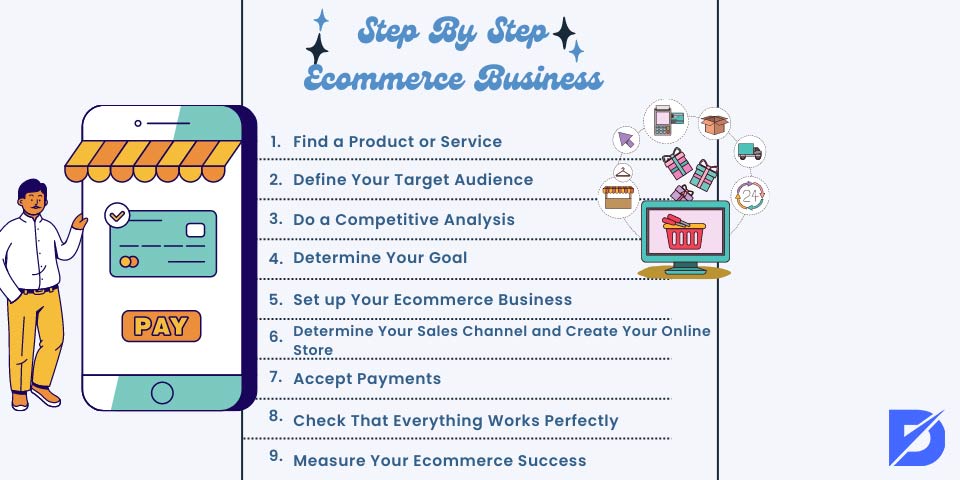
Step By Step Ecommerce Business
We all make online purchases from websites, mobile apps, or even social media platforms. But what if you want to sell your products? You can sell your products or services online on different websites, but you may not know where to start this adventure.
Starting an eCommerce business is a long and effortful process, but don’t worry. We are going to cover it with 9 different steps to ecommerce business ideas. Let’s start with the most important one.
Find a Product or Service
First and foremost, find a product or service to sell online when you start an eCommerce business. It’s easy if you already have an actual offline store; you can sell your existing products or services online. However, if you don’t know what to sell, it might be the most challenging part of your business before you start. Since the possibilities are endless, you need to understand which types of business will bring success and money.
When you set up an eCommerce business, you will come across thousands of ideas. If you are not sure what to sell, here are five niches.
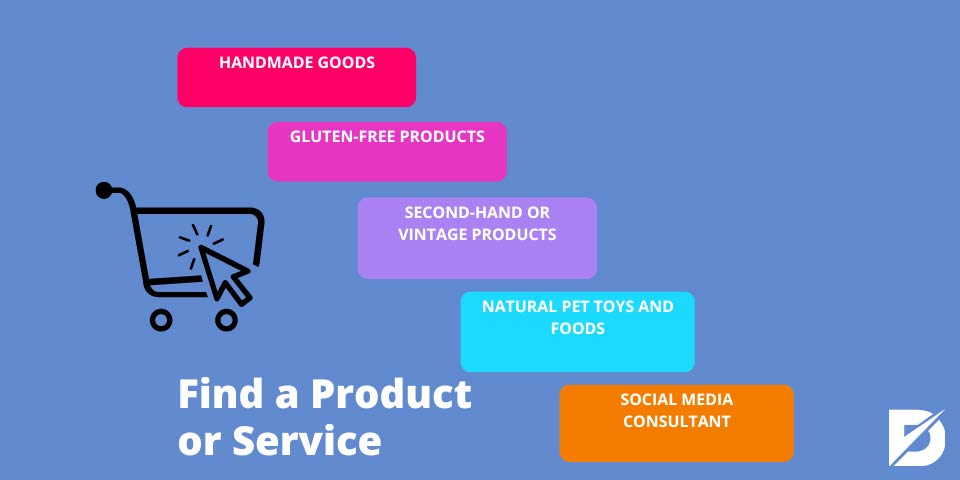
- Handmade goods: If you trust your hand-tase, then you can produce food products like chocolate, bread, and cake. Or, you can create fashion/jewelry products like necklaces or earrings. You can also sell handmade beauty products such as face soap or hand cream that you produce.
- Gluten-free products: Gluten-free products are a perfect niche you can take advantage of. When you serve people with gluten sensitivity, you can get ahead of many food producers in a short while.
- Second-hand or vintage products: Take a look at your grandmother’s garderobe to find unique blouses and trousers, and sell them with her permission. Or, if you already have many clothes in the same style, keep only the ones you like the most and sell the rest.
- Natural pet toys and foods: Nowadays, many dog owners would like to purchase pupcakes – dog cupcakes with frosting; it is a perfect niche you can take advantage of.
- Social media consultant: If you have some experience on different social media platforms, you can help other people manage their social media accounts and campaigns for a fee.
Define Your Target Audience
To be successful in your eCommerce business, you should perfectly understand how to define a target audience for SEO and, of course, for your business. There are different ways to understand their needs, wants, and preferences. For example, you can begin by analyzing who your existing competitors are in the industry. It will help you figure out who they are selling products to. Or, you can make open-ended or closed surveys to understand your customers’ demographics, such as age, gender, the country they live in, buying habits, or even purchasing power.
Since psychographic data greatly impacts how people think when making a purchase decision, such data should also be considered. You should try to reach customers’ emotions, personal values, interests, and hobbies.
Do a Competitive Analysis
Now, it is time to determine who your competitors are. Before starting your eCommerce business, you should understand what products or services your competitors offer and understand their sales tactics and results. Thus, you can take lessons from their failures and try not to make the same mistakes too.
With a good competitive analysis, you will be able to understand how you can differentiate your brand from others. At this point, you may wonder what is SWOT analysis in marketing. It plays an important role for especially startups. Let’s look at it in a more detailed way.
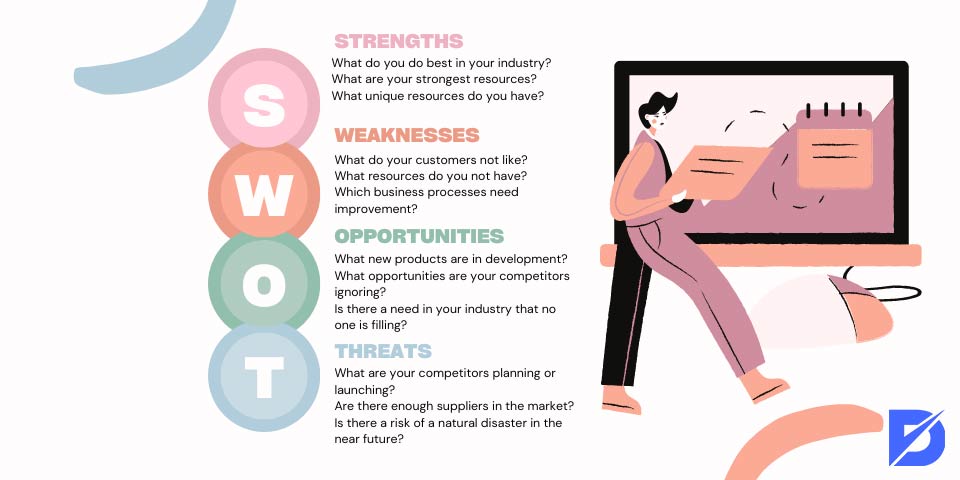
Strengths
Strengths are the internal and positive sides of your business. Ask yourself,
- What do you do best in your industry?
- What are your strongest resources? (knowledge, employees, equipment, technology, or capital)
- What unique resources do you have?
- How is your brand different from your competitors?
- What do your customers love about your offerings?
- What are you doing that no one else has done before?
Weaknesses
Weaknesses are the internal and negative sides of your business. Ask yourself,
- What do your customers not like?
- What resources do you not have?
- Also, what are your competitors doing better than you?
- Which business processes need improvement?
- What expertise, technology, or equipment do you lack?
- Do you need more employees to provide a better customer experience?
- Do you need much more equipment to help your business run smoothly?
Opportunities
Opportunities are positive things that exist in the external environment of your business. Ask yourself,
- What new products are in development?
- What opportunities are your competitors ignoring?
- Is there a need in your industry that no one is filling?
- What trends might positively affect your brand?
- How can you outperform your competitors by offering something they don’t?
- Is there a niche market that your competitors are not addressing well?
- Are there new technologies or resources to improve your brand?
- Do your competitors have any weaknesses that you can exploit?
Threats
Threats are negative things that exist in the external environment of your business. Ask yourself,
- Has there been a decrease in the number of your loyal customers? Is it because of predatory pricing or something else?
- What are your competitors planning or launching?
- Why do your customers buy from your competitors but not from you?
- Are there enough suppliers in the market? Are they reliable?
- Is there a risk of a natural disaster in the near future?
- Has there been an increase in the price of your raw materials?
- What are the recent rules and regulations that might impact your business negatively?
To answer these questions, all you need is a pen and paper. At the end of the day, you will be able to figure out which part of your business you need to focus on and invest more.
Determine Your Goal
Now, it’s time to set a simple goal. Of course, these goals can vary, depending on many factors like your products or services, business size, industry type, or even the number of customers and competitors you have. How are you going to define your eCommerce goals? Ask yourself, ‘What do I want to achieve through an Ecommerce business?’ You might want to let customers search your inventory. Or, you might want to offer a service that allows people to make their shopping process easier and faster. Or, you might want to develop your customer relations and increase the number of loyal customers.
Set up Your Ecommerce Business
After finding a product or service to sell, analyzing the competition, and determining your business goals, it’s time to start an eCommerce business. Therefore, to reach your audience effectively and efficiently, we’ve listed three essential substages.

Find Your Business Name
Picking the right name will have a significant impact on your whole business life. That’s why you will want to find a business name that is unique, easy to remember, and catchy. At this point, you may ask, ‘How do I select the perfect name for my business?’ If you have trouble coming up with a business name, don’t worry. We are going to share with you several ideas and inspiration to help you decide on the best name for your startup.
- Ask your family and close friends: There is nothing more creative than brainstorming. You can ask your family, close friends, or even former co-workers for help finding the best business name.
- Keyword and market research: Keyword and market research will help your customers have a clear understanding of what your business is and does, as the right business name should give an idea of what you’re selling. In this case, you can use Google’s free tools like Google Trends or Keyword Planner.
- Online business name generators: There are hundreds of free and paid business name generators out there. Neelix, Shopify, businessnamegenerator.com, Oberlo, and NameSnak can help you discover perfect business name ideas.

3 Tips For Finding The Best Business Name
- Keep it short and simple: A short and simple name will be remembered by your customers easier.
- Be unique and original: You don’t want to use a name that’s similar to your competitor’s name, do you? Try to think differently.
- Be flexible: You should find a name that can be adapted if you enter a new market or launch a different product. Try to avoid using specific words in your business name.
Register A Domain Name
Once you’ve chosen a brand name, it’s time to find your domain name. In this case, the most important thing is to make sure the domain name that you want is available for purchase. To understand whether the domain has already been taken, check the best domain registrar options you can use, such as GoDaddy, Shopify, or Bluehost. Here, there are two possibilities. Your business name is available to register, or someone else is already using it. At this point, you have two options: the established domain name can be purchased from the owner of that domain, or you can look at different alternatives.
There are several tips when choosing your domain name from scratch. The domain name;
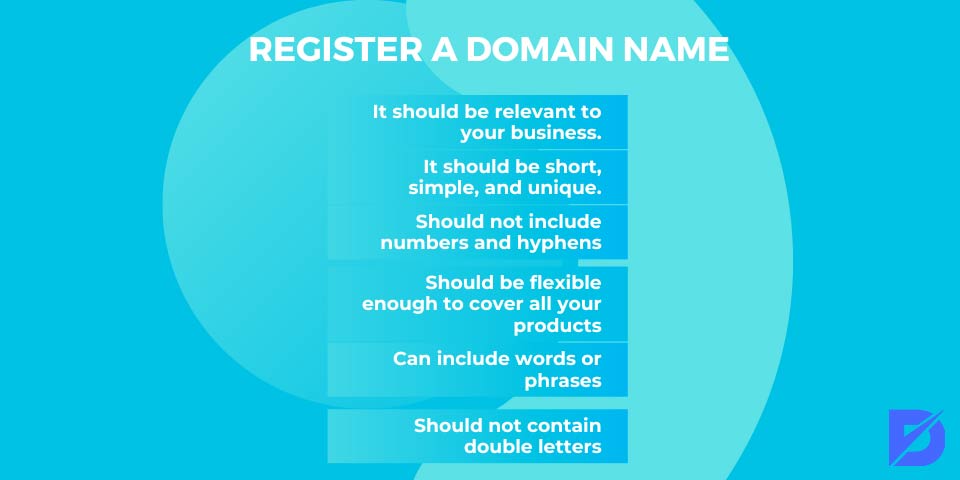
- It should be relevant to your business and products or services.
- It should be short, simple, unique, catchy, and easy to remember.
- Should not include numbers and hyphens because these make it difficult to remember and difficult to say.
- It should be flexible enough to cover all your products if you decide to sell different types of products in the future.
- It can include words or phrases that make it brandable.
- It should not contain double letters because it is difficult to type.
Choose a Domain Suffix
After finding a domain name, choose a domain name suffix like ‘.com,’ ‘.net,’ or .org.’
Well, let’s say you’ve found a perfect domain name and suffix that’s relevant to your business and products. Now, you should immediately register it for your eCommerce business before someone else does. There are many free domain name registrars and website hosting providers available on the internet. For example, you can use Wix, Bluehost, GoDaddy, BuyDomains, Domain.com, or Google Domains.
Registering a new domain name or purchasing one that has already been taken by someone else will directly affect the price you pay. For example, an established domain name will likely be a lot more expensive.
Create Your Business Logo
You are very close to starting an eCommerce business, but you’re not done yet. Aside from finding a good business name and domain name, another challenging decision is creating your business logo. Since a good logo is a quick representation of your brand, it helps you separate your business from your competitors in the industry. With a good logo, customers can understand who you are, what you do, and what you sell. Don’t forget that a good logo makes you recognizable.
There are millions of logo generators and apps that let you create a well-designed logo. You can use Canva, BrandCrowd, Looka, Tailor Brands, or Adabo Logo Maker. However, it doesn’t matter which one you will use; you should consider several fundamental principles when designing a logo for your eCommerce shop.
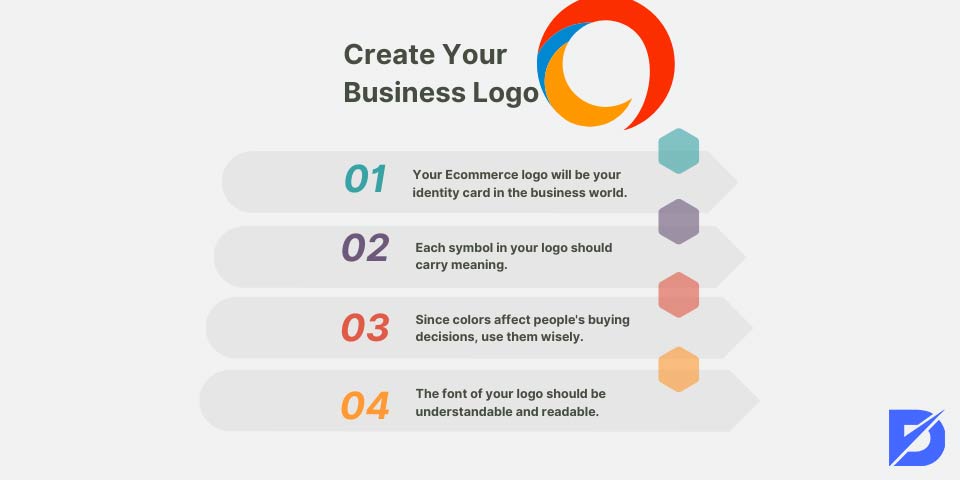
- Your Ecommerce logo will be your identity card in the business world. So, you have to make sure that no one else has the same or even a similar logo.
- Each symbol in your logo should carry meaning. For example, if you sell gluten-free products on your eCommerce website, don’t use the rye symbol in your logo.
- Since colors affect people’s buying decisions, use them wisely. For example, if you are going to start an ecommerce business in the food industry, you can use the red color in the logo to make people feel hungry.
- The font of your logo should be understandable and readable. If you use difficult-to-read fonts like Xingkai TC or Nanum Pen Script, avoid using words whose meanings change with just one letter.
Determine Your Sales Channel and Create Your Online Store
Let’s say you’ve found a name, registered a domain name, and created a logo. Everything is perfect up to this point. However, this point is where you have to make a vital decision: Sell your products by building your own website or using an established eCommerce platform like Amazon or eBay.
Sell your products on established online marketplaces.
There are lots of online marketplaces that help you start selling online. Since such platforms are a good, cost-effective, and less risky option, they can be a good starting point for anyone who wants to reduce the possibility of failure. Think about Amazon or eBay, which are middlemen between third-party sellers and people looking to purchase. All you need is a laptop, internet access, and a seller account on such websites.
Sell your products on your own eCommerce website.
Let’s say, after much thought, you have decided to sell your products on your own eCommerce website instead of using an online marketplace.
In this case, there are literally hundreds of eCommerce platforms available with all the features you need, whatever you are selling or whoever you are selling to.
BigCommerce, Shopify, Wix, WooCommerce, and Square are the most popular eCommerce website builders, where you can create your own eCommerce store. Just select the best platform that offers all the features you need.
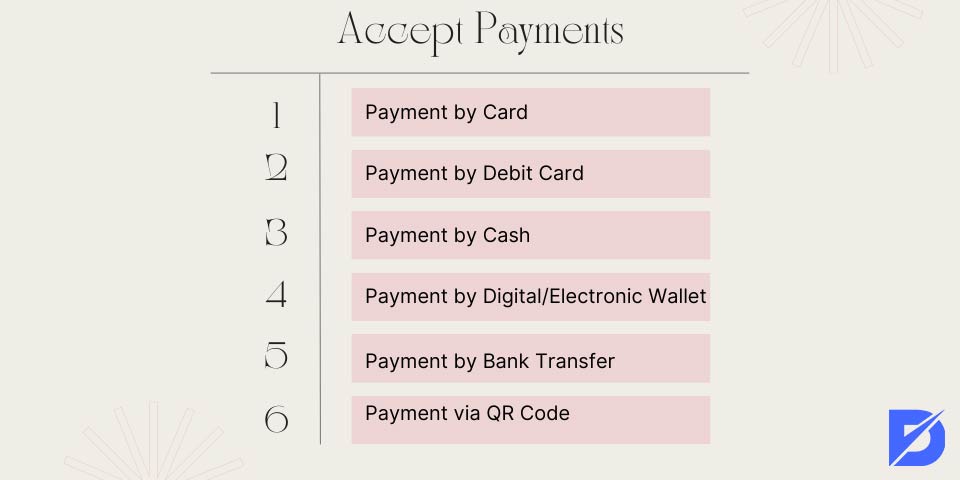
Accept Payments
Now, it’s time to ask, ‘How do I integrate a payment gateway to my eCommerce website?’ Thanks to advanced technologies, there are lauds of online payment options that you and your customers can use. To provide a good customer experience, using a wide range of payment methods is very important.
Payment by Card
As you may guess, paying with credit cards is the most preferred payment method across the world. On the checkout page, customers should enter their card details, such as the cardholder’s name, the card expiry date, and Card Verification Value (CVV).
Payment by Debit Card
Paying with debit cards is the second-used method in the world. These types of cards let customers use their savings in their bank accounts. Therefore, debit cards are an excellent opportunity for people who don’t want to exceed their financial limits.
Payment by Cash
Everyone knows online payment methods have loads of advantages, but there are disadvantages too. Because of security problems, people may want to use this method. Besides, payment by cash is a good option for shoppers who are not using any cards.
Payment by Digital/Electronic Wallet
Payment by digital wallet lets people save their personal financial information on a cloud-based system. The only difference between digital wallets and other payment methods (cash, credit, or debit cards) is that digital wallets are virtual.
Payment by Bank Transfer
Since online payments carry the risk of thieves stealing credit or debit card information, people may not want to give their card details. In this case, a bank transfer is the most secure online payment method because the account holder will verify each purchase from an eCommerce website.
Payment via QR Code
With the recent technological development, payment via QR code has become more and more popular. Since this method is easy to use, fast, and user-friendly, people can easily purchase products and services.
In addition to the payment methods above, you can also use ‘Third Party Payment Processors such as Square, Paypal, Stax, Nochex, and Stripe. Also, these payment options allow you to add a button to your site where people can make payments. The main difference between third-party payment processors and the methods above is clear. If you integrate a third-party payment processing tool into your website, customers will be redirected to another website where the payment will be processed. After they have completed the order process, they will be turned back to your website.
Before we wrap up this step, let’s not forget a pretty important thing. You should try to minimize the steps to complete the purchase. For example, you can add a button that allows customers to use shipping addresses as billing addresses to speed up the purchasing process.
Check That Everything Works Perfectly
There are only a few points left to consider before making money via your online retail business. To provide a better shopping experience for your customers, make sure all buttons on your site are working and clickable. Besides, your eCommerce site’s pages can be viewed perfectly on all the different devices your customers might use. Then, you can get ready to start an eCommerce business.
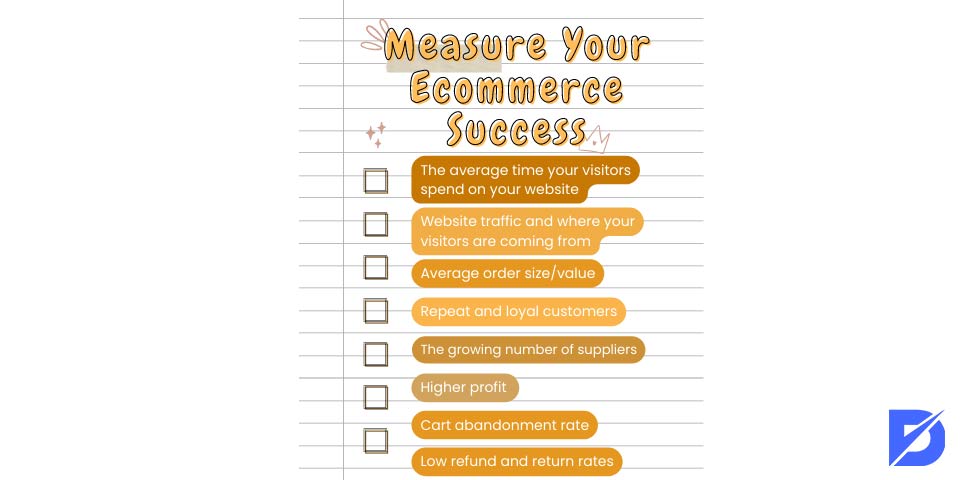
Measure Your Ecommerce Success
Congratulations, you are on the last step! Once you start an eCommerce business and market your products or services, you will want to understand what is going well and what is not. Now, here are eight ways that you can measure the success of your ecommerce business.
- The average time your visitors spend on your website
- Website traffic and where your visitors are coming from
- Average order size/value
- Repeat and loyal customers
- The growing number of suppliers
- Higher profit
- Cart abandonment rate
- Low refund and return rates
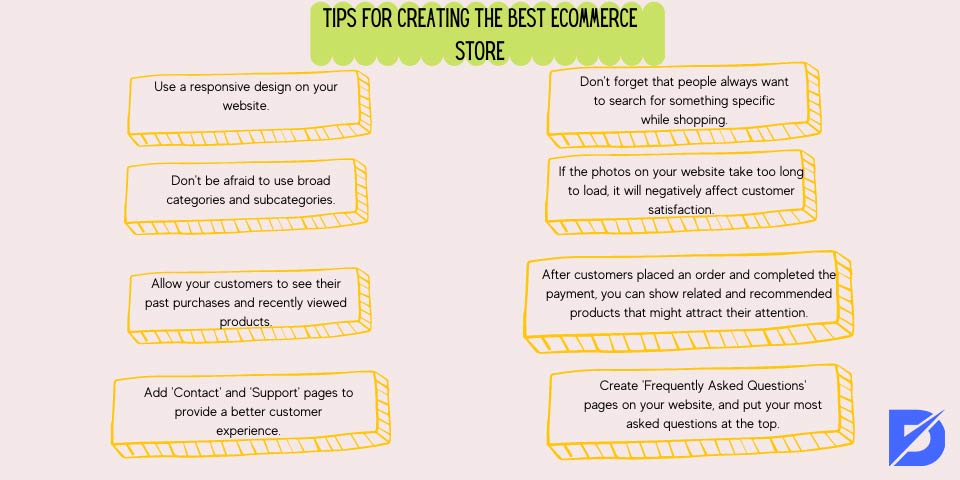
Tips for Creating the Best Ecommerce Store
If you want to start an eCommerce business what is perfect, you should consider these tips before you open an eCommerce store:
- Use a responsive design on your website.
This type of design will allow you to adapt your pages to different screen sizes, from big desktop screens to relatively small mobile device screens. - Don’t forget that people always want to search for something specific while shopping.
That’s why using a search box on your website will make them happy. Thus, customers can easily browse and find what they are looking for. - Don’t be afraid to use broad categories and subcategories.
They will not only let you organize your inventory but also help people find what they are looking for. - If the photos on your website take too long to load, it will negatively affect customer satisfaction.
Use high-resolution product photos and make sure they load fast. - Allow your customers to see their past purchases and recently viewed products.
These features will encourage them to buy more. - After customers place an order and complete the payment, you can show related and recommended products that might attract their attention.
Add your products along with the product details, including product photos from different angles, short videos, detailed descriptions, or even customer reviews. - Add ‘Contact’ and ‘Support’ pages to provide a better customer experience.
Update your phone number, email addresses, and social media accounts if needed. - Create ‘Frequently Asked Questions’ pages on your website, and put your most asked questions at the top.
Try to answer the basic questions which are related to shipping and return policies. For example, a customer should find the answer to ‘How long does it take to receive my order?’ ‘How many days do I have to return a product?’ or ‘What products cannot be returned?’
Start an Ecommerce Business In Short
Ecommerce is the short name for selling your products or services online, but creating an eCommerce store is not easy. So, there are loads of steps you should perfectly follow to start eCommerce business. In our guide, we’ve listed them under nine titles. After deciding on what to sell, you should determine who your target audience and competitors are. Then, you should find a name, domain name, and logo. If everything is perfect, you will decide: “Where do you want to sell your products?” You can sell them on online marketplaces or set up your own website. At the end of our guide, we also gave you some tips for creating the best eCommerce store. Whatever option you select, selling your products online is a fantastic way to reach more people and grow your brand.
Frequently Asked Questions About
People may not add your products to their shopping basket, so check the buttons that allow them to do this.
Encouraging them to create an account is one of the best things to do. After they have an account, you can send reminder messages for specific products.
Absolutely! SEO will help you be ranked on the first page of search engines so you can grow your business by reaching more people.
Amazon, eBay, AliExpress, Walmart, Etsy, Rakuten, Alibaba, etc.
What are the best eCommerce tools to start an eCommerce business? As we said above, BigCommerce, Shopify, Wix, WooCommerce, and Square are some of the most popular eCommerce website builders. You can also take advantage of Google Analytics, Keyword Search, Search Console, SemRuhs, or Ahrefs to drive more traffic to your website and increase the number of customers.

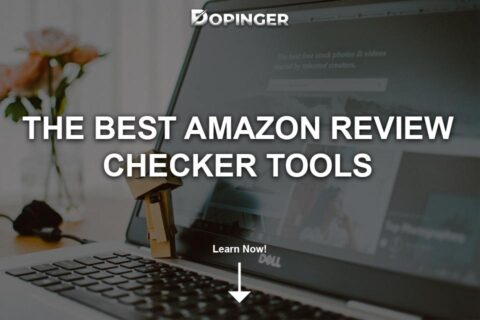
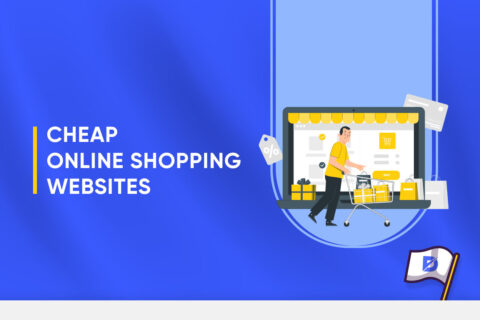

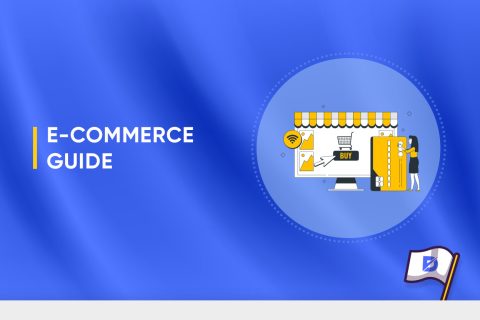
No comments to show.